Receiving a diabetes diagnosis can feel like the world has suddenly shrunk. The foods you once enjoyed are now sources of anxiety, and every meal becomes a complex calculation. This constant mental load is exhausting, but it does not have to be your reality. The truth is, managing your blood sugar through food is less about restriction and more about discovery and empowerment. It is about using simple, delicious, and nourishing meals to take back control of your health and well-being.
Table of Contents
This guide is designed to be your clear, actionable starting point. We are moving beyond the confusion to provide a straightforward and effective 7-day diabetes meal plan that removes the guesswork. This is not just an arbitrary collection of recipes; it is a strategic menu meticulously built upon the latest clinical guidelines from the American Diabetes Association (ADA) and aligned with the World Health Organization’s (WHO) global health standards. With over 38 million Americans living with diabetes, having a plan that is both medically sound and realistically simple is more important than ever.
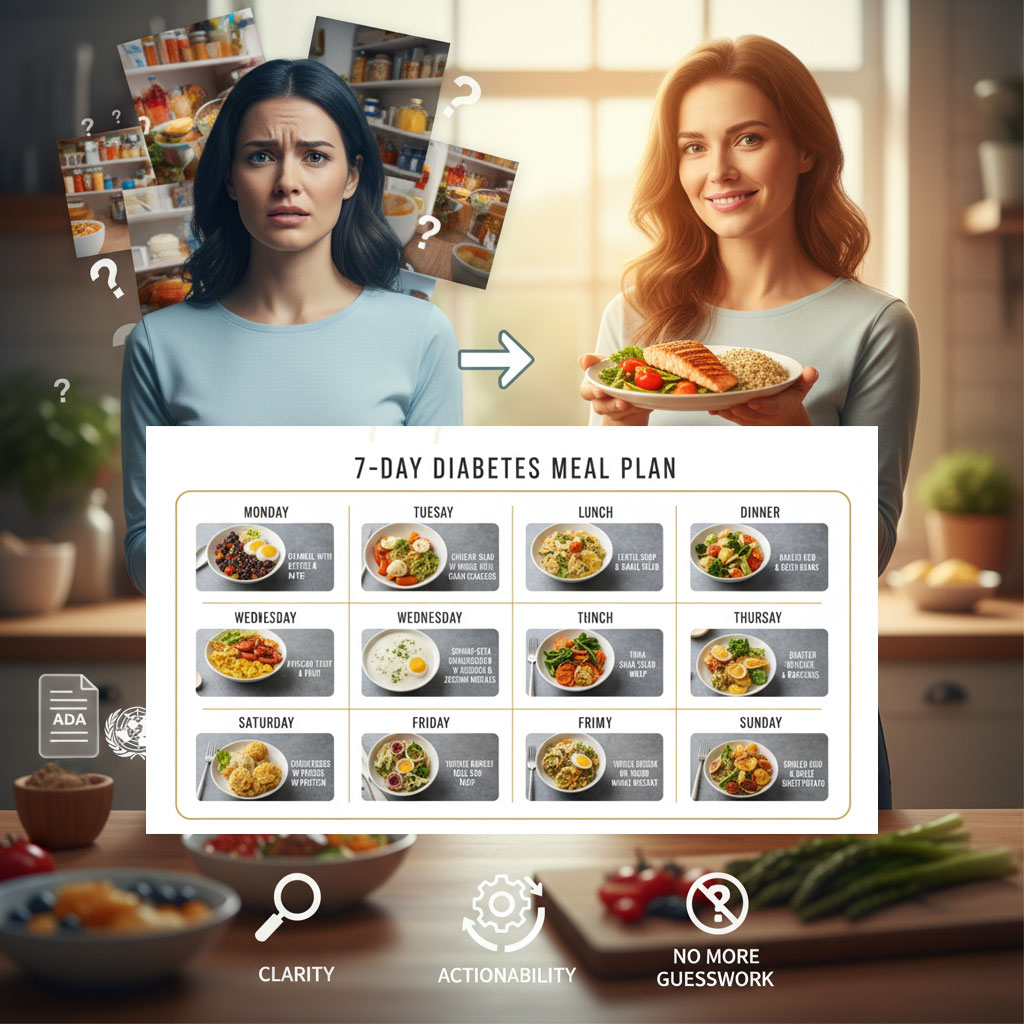
The Science of a Simple, Effective Diabetes Diet
A successful diabetes diet is not about a single magic food or the complete elimination of entire food groups. It is about creating a sustainable, enjoyable pattern of eating that keeps your blood glucose levels stable, nourishes your body, and fits into your real life. The foundational principles are far simpler than you might have been led to believe, focusing on balance, quality, and consistency.
Understanding the “Why”: ADA and WHO Guidelines
The most current ADA diabetes nutrition guidelines represent a significant shift away from rigid, one-size-fits-all diets. Today, the focus is on a personalized approach centered on nutrient-dense, whole foods. These guidelines emphasize several key pillars that form the bedrock of this diabetes diet plan for the USA, ensuring it is both safe and effective.
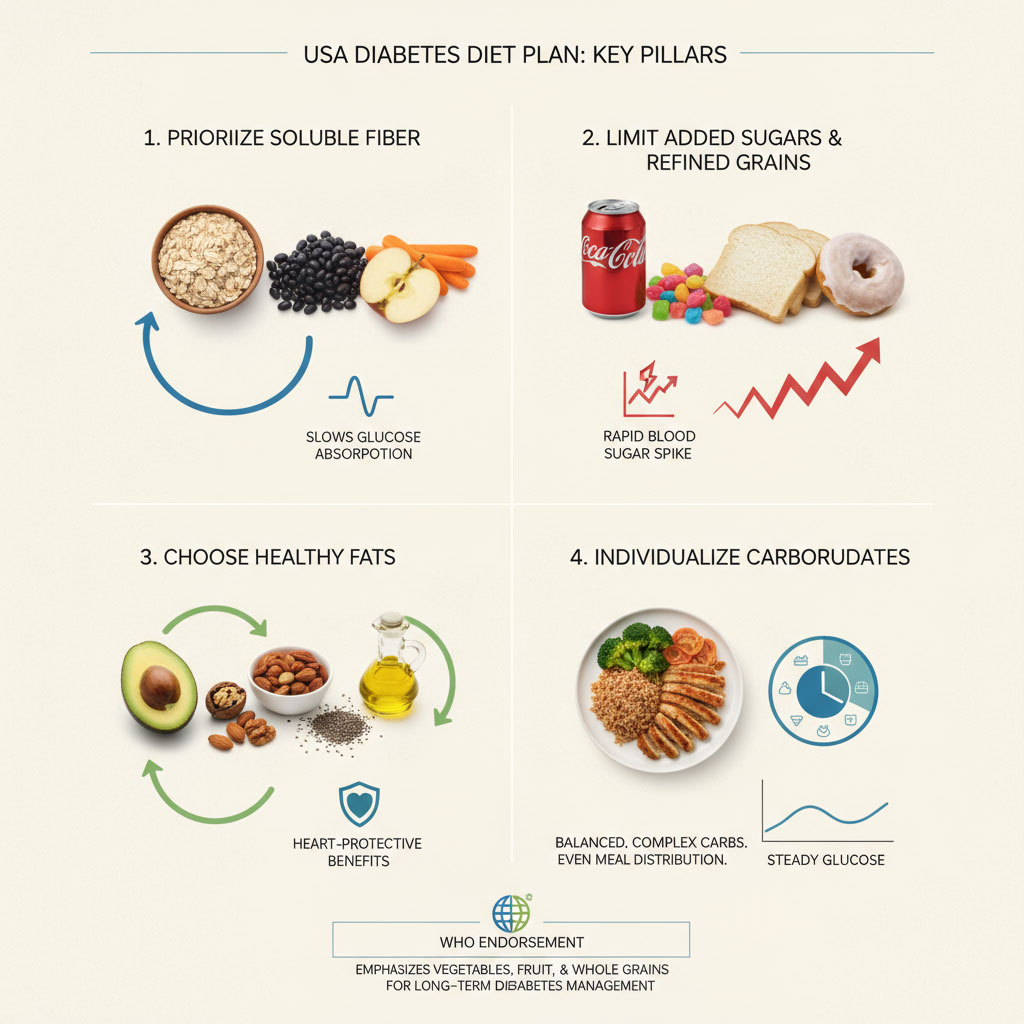
Key recommendations include:
- Prioritizing Fiber: Soluble fiber, found abundantly in oats, beans, apples, and carrots, is a superstar in diabetes management. It forms a gel-like substance in the digestive tract, which slows the absorption of glucose into the bloodstream, preventing sharp spikes after meals.
- Limiting Added Sugars and Refined Grains: Foods high in added sugars (like soda and candy) and those made from refined white flour (like white bread and pastries) are digested very quickly, causing a rapid and often dramatic rise in blood sugar levels.
- Choosing Healthy Fats: Not all fats are created equal. Monounsaturated and polyunsaturated fats, found in avocados, nuts, seeds, and olive oil, are incredibly beneficial for heart health. This is critical, as individuals with diabetes have a higher risk of cardiovascular disease.
- Individualizing Carbohydrates: There is no universal “right” amount of carbohydrates. The modern approach focuses on choosing high-quality, complex carbohydrates rich in fiber and distributing them evenly throughout the day to maintain steady energy and glucose levels.
The WHO strongly supports this nuanced approach, advocating for dietary patterns rich in vegetables, fruits, and whole grains as a primary strategy to manage diabetes and reduce the long-term risk of complications.
The Plate Method: Visualizing Your Perfect Meal Without Counting
For many people navigating type 2 diabetes, the single most empowering tool for creating balanced diabetic meals is the Plate Method. This simple, visual technique, championed by respected health systems like Sutter Health for its real-world practicality, requires no complex weighing, measuring, or counting. It is a skill you can use anywhere, from your own kitchen to a restaurant.
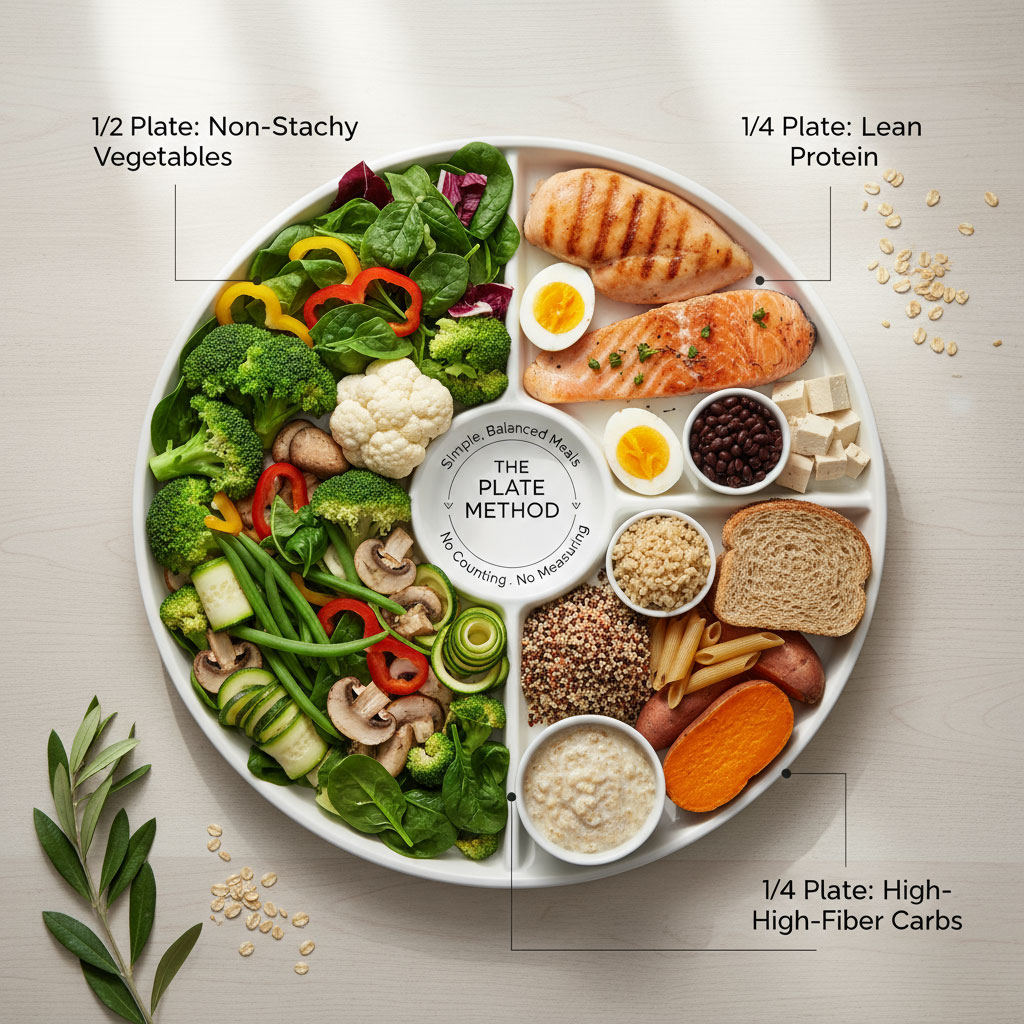
Here is how you build your plate for optimal balance:
- Fill Half Your Plate with Non-Starchy Vegetables: This should be the largest section of your plate. Load it up with colorful options like broccoli, spinach, salad greens, bell peppers, cauliflower, green beans, mushrooms, and zucchini. These foods are low in carbohydrates and calories but packed with vitamins, minerals, and fiber.
- Fill One Quarter of Your Plate with Lean Protein: This section is for foods that promote satiety and have a minimal impact on blood sugar. Excellent choices include skinless chicken or turkey, fish like salmon or tuna, eggs, beans, lentils, and tofu. Protein is essential for muscle health and helps keep you feeling full longer.
- Fill the Final Quarter with Carbohydrate Foods: This section provides your body with its primary source of energy. The key is to choose high-quality, high-fiber options. Think quinoa, brown rice, whole-wheat bread or pasta, oats, or a small sweet potato. These are digested more slowly than their refined counterparts.
This intuitive method naturally controls your portions and ensures you get a healthy, satisfying balance of macronutrients at every single meal. It is a core component of a successful American Diabetes Association meal plan because it is a sustainable habit, not a diet.
Your Actionable 7-Day Diabetes Meal Plan
This sample diabetic patient meal menu is designed for maximum simplicity without sacrificing flavor or nutritional value. Remember to drink plenty of water throughout the day, as proper hydration is key for blood sugar regulation. Portions can and should be adjusted based on your individual energy needs, activity level, and the specific guidance from your healthcare team. Think of this as your foundational template, full of delicious diabetes friendly recipes.
Monday: A Fresh Start
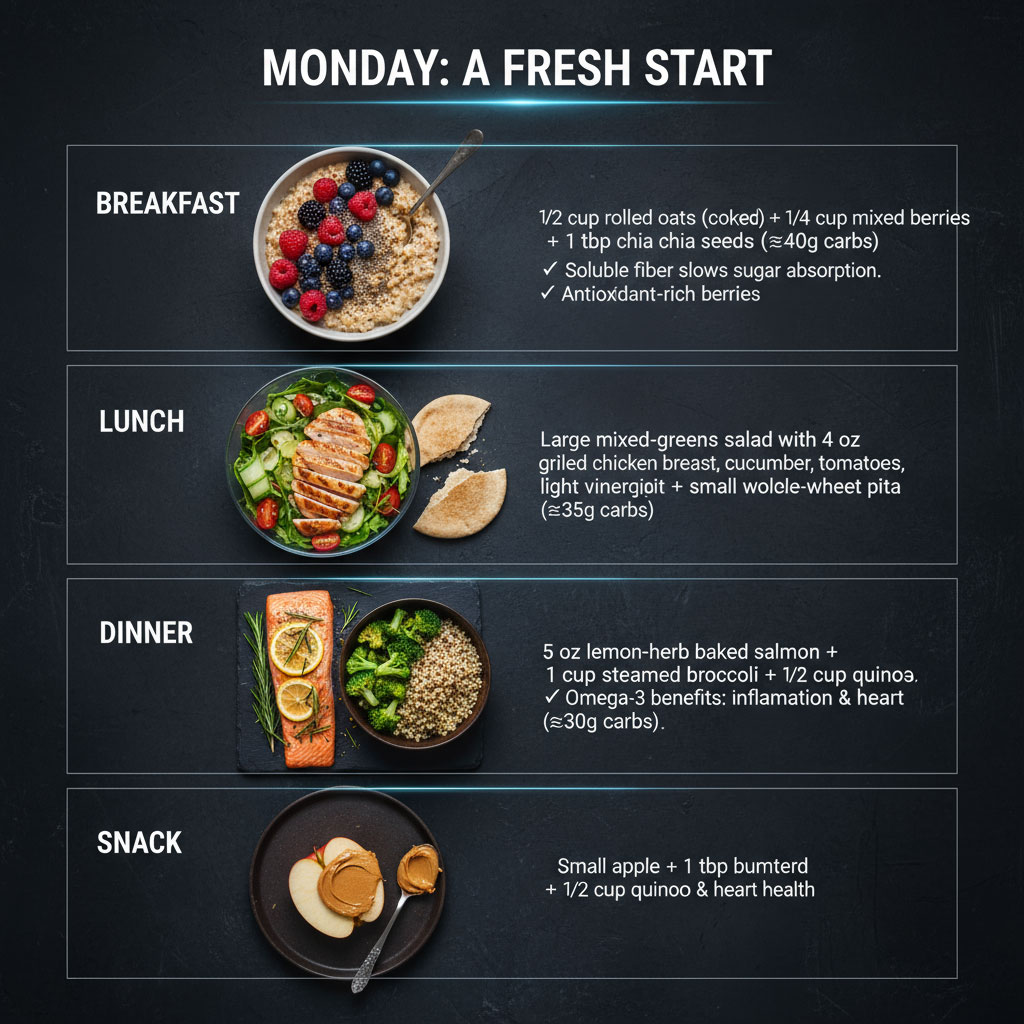
- Breakfast: 1/2 cup rolled oats cooked with water, topped with 1/4 cup mixed berries and 1 tablespoon of chia seeds. (Approx. 40g carbs)
- Why this works: The soluble fiber in oats and chia seeds slows down sugar absorption, while the berries provide antioxidants without a large sugar load.
- Lunch: Large salad with mixed greens, 4 oz grilled chicken breast, cucumber, and tomatoes with a light vinaigrette. Serve with a small whole-wheat pita. (Approx. 35g carbs)
- Dinner: 5 oz baked salmon seasoned with lemon and herbs, served with 1 cup of steamed broccoli and 1/2 cup of quinoa. (Approx. 30g carbs)
- Pro Tip: Salmon is rich in omega-3 fatty acids, which are crucial for reducing inflammation and protecting heart health, a primary concern in diabetes management.
- Snack: A small apple with 1 tablespoon of almond butter.
Tuesday: Building Momentum
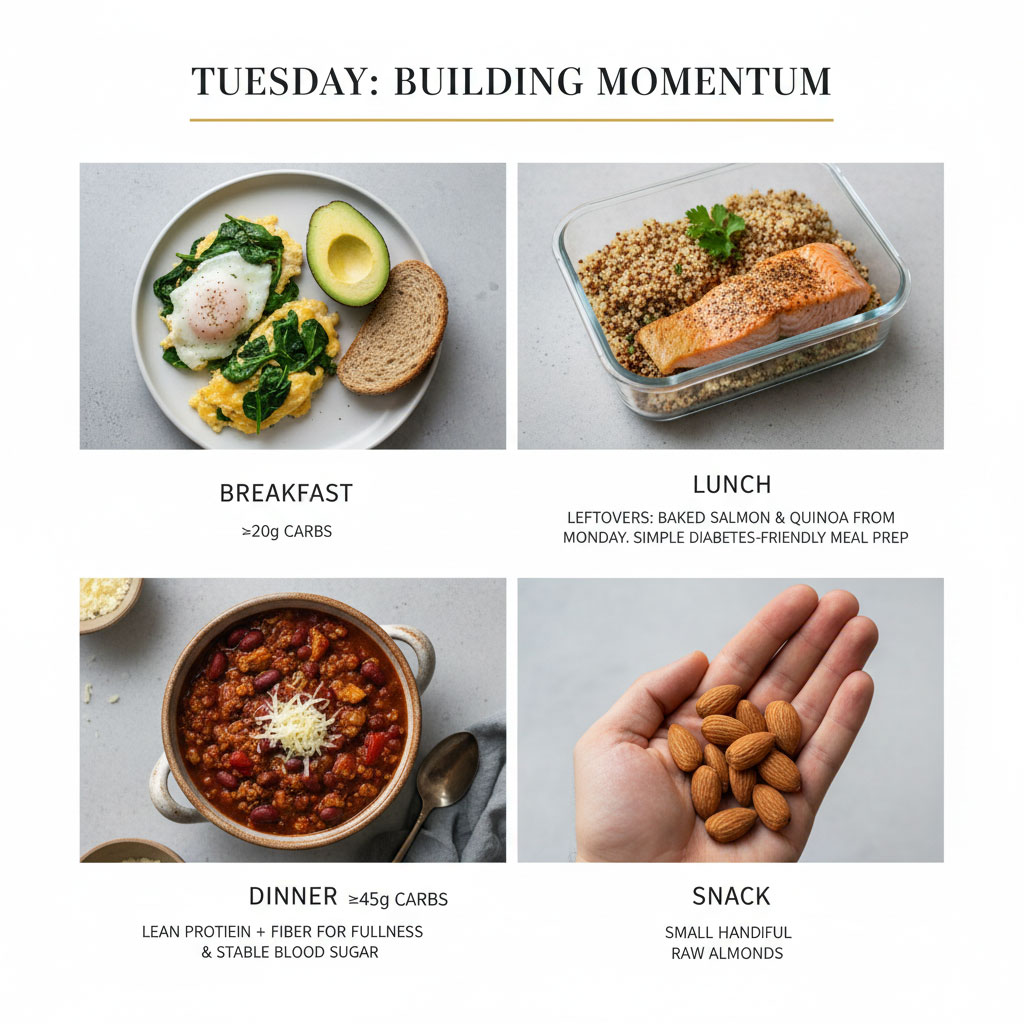
- Breakfast: 2 scrambled eggs with a handful of spinach and 1/4 avocado, served with one slice of whole-grain toast. (Approx. 20g carbs)
- Lunch: Leftover baked salmon and quinoa from Monday. This is the secret to easy diabetes meal prep; cook once, eat twice.
- Dinner: 1.5 cups of hearty turkey chili made with lean ground turkey, kidney beans, and diced tomatoes. Top with a sprinkle of low-fat cheddar cheese. (Approx. 45g carbs)
- Why this works: The combination of lean protein from the turkey and high fiber from the beans makes this a very filling meal that has a minimal impact on blood sugar.
- Snack: A small handful of raw almonds.
Wednesday: Plant-Forward Power
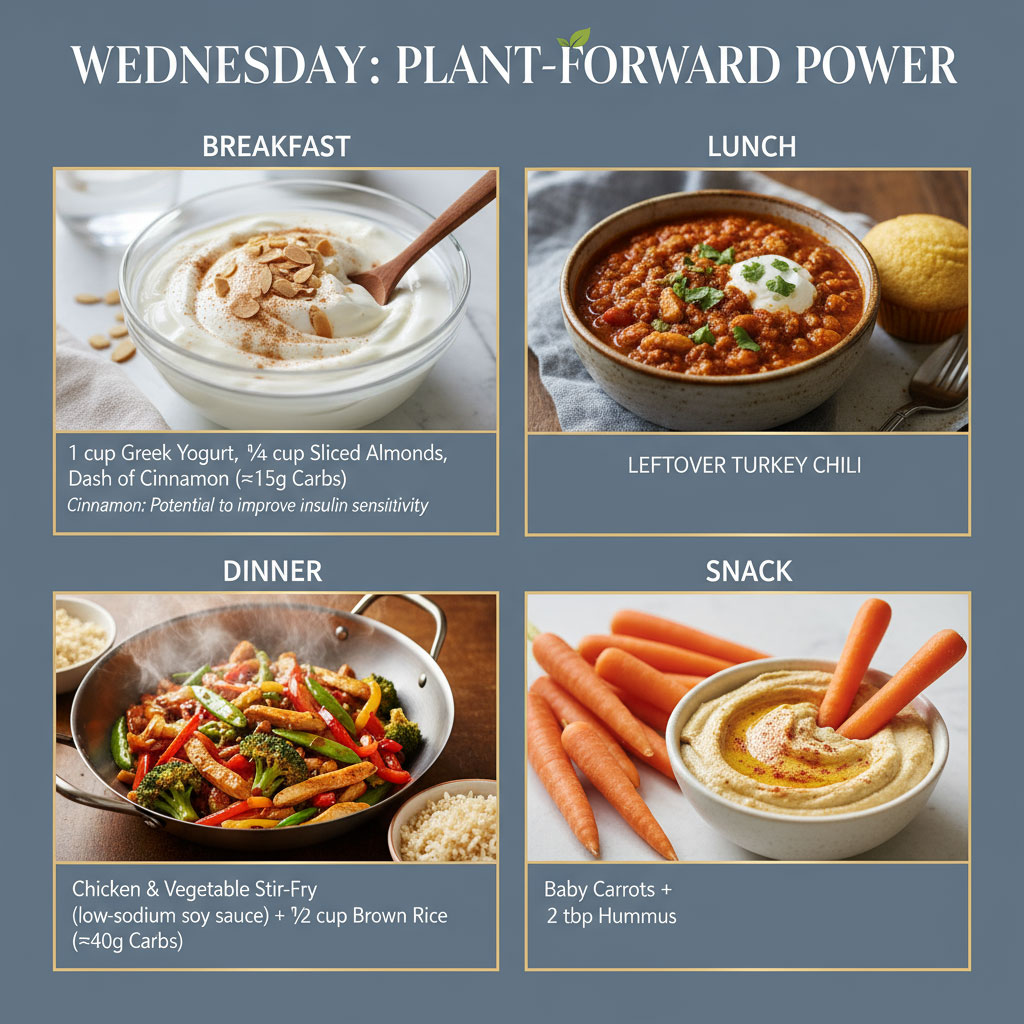
- Breakfast: 1 cup of plain Greek yogurt mixed with 1/4 cup of sliced almonds and a dash of cinnamon. (Approx. 15g carbs)
- Pro Tip: Cinnamon has been shown in some studies to help improve insulin sensitivity. Plus, it adds flavor without any sugar.
- Lunch: Leftover turkey chili.
- Dinner: A delicious meal from a plant-based diabetes diet: a vibrant chicken and vegetable stir-fry with sliced chicken breast, bell peppers, snap peas, and broccoli in a low-sodium soy sauce. Serve with 1/2 cup of brown rice. (Approx. 40g carbs)
- Snack: Baby carrots with 2 tablespoons of hummus.
Thursday: Healthy Fats Focus
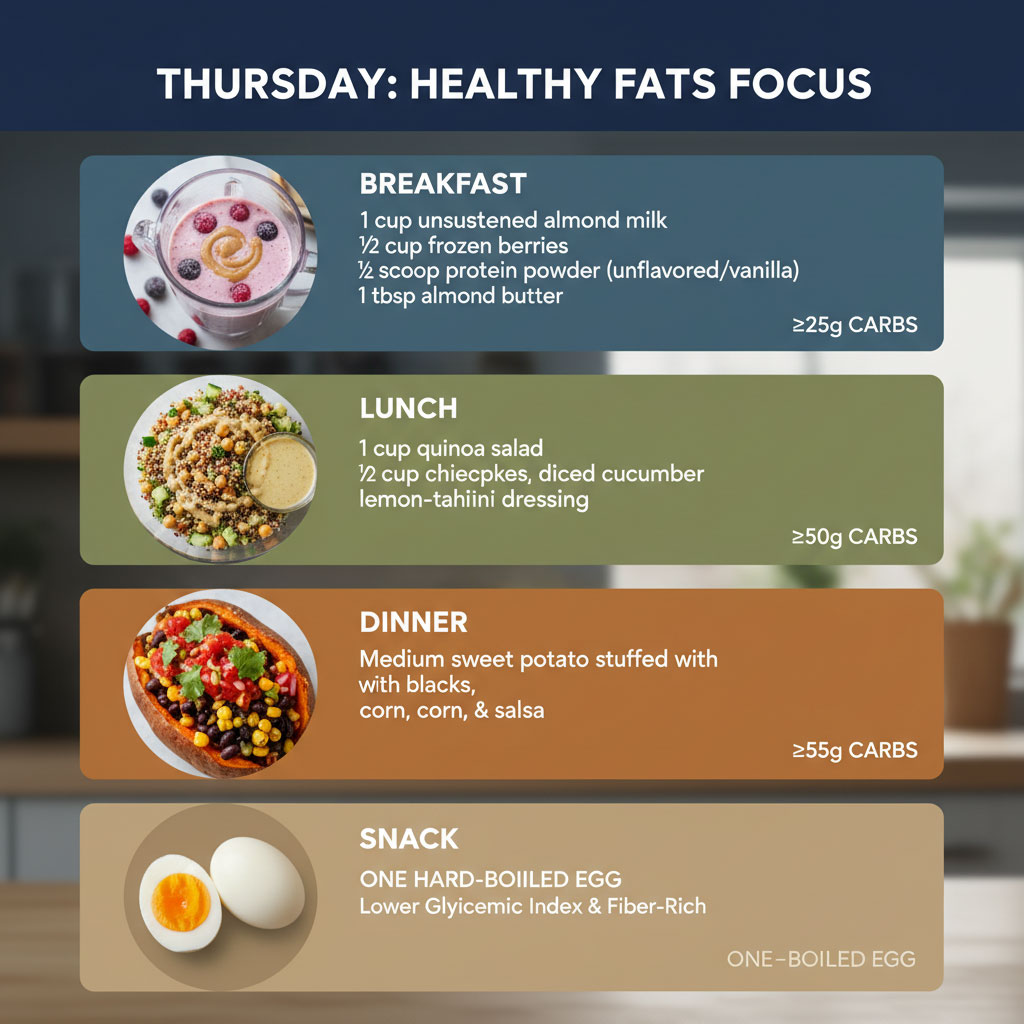
- Breakfast: Smoothie made with 1 cup unsweetened almond milk, 1/2 cup frozen berries, 1 scoop of unflavored or vanilla protein powder, and 1 tablespoon of almond butter. (Approx. 25g carbs)
- Lunch: Refreshing quinoa salad (1 cup) mixed with 1/2 cup chickpeas, diced cucumber, and a bright lemon-tahini dressing. (Approx. 50g carbs)
- Dinner: One medium-sized sweet potato stuffed with black beans, corn, and salsa. This is a simple but incredibly satisfying meal full of glucose control foods. (Approx. 55g carbs)
- Why this works: Sweet potatoes have a lower glycemic index than white potatoes, meaning they raise blood sugar more slowly. Paired with fiber-rich beans, it is a winning combination.
- Snack: One hard-boiled egg.
Friday: A Healthy Twist on a Favorite
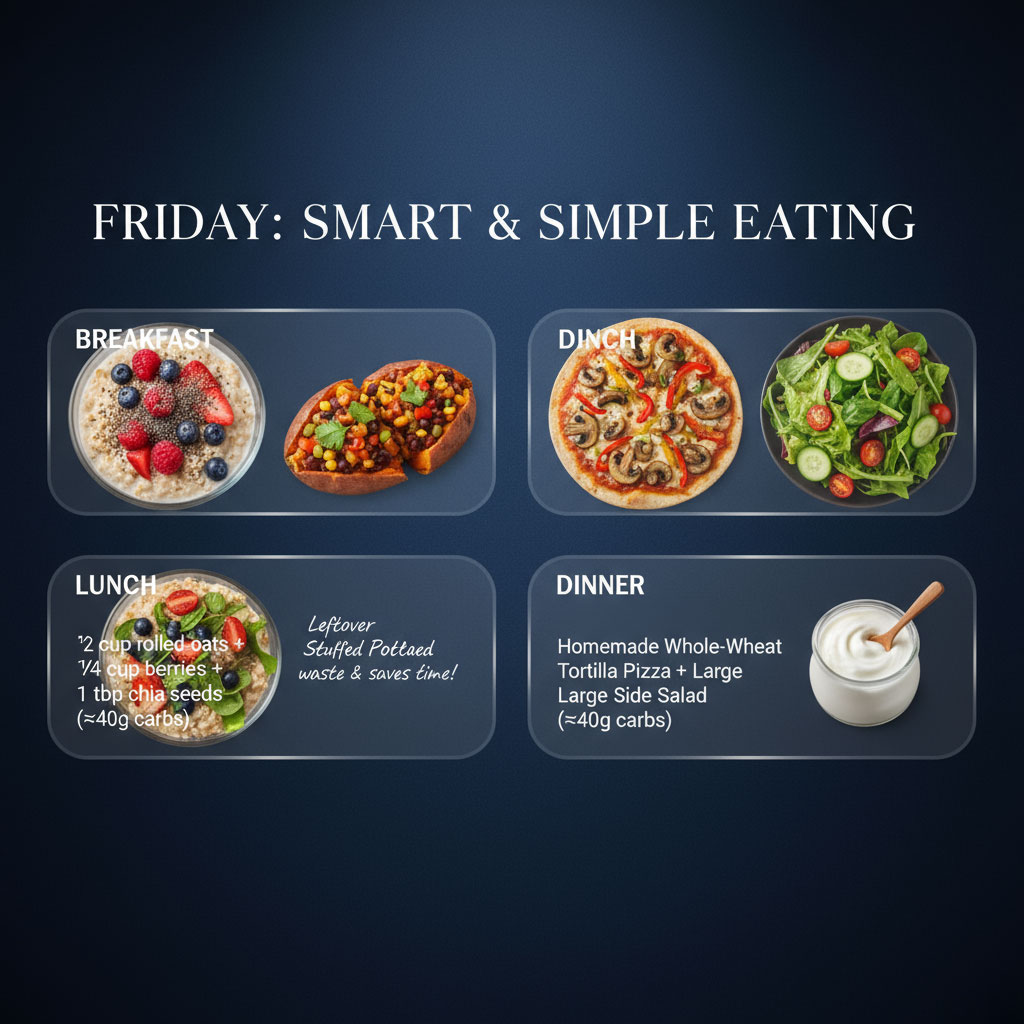
- Breakfast: 1/2 cup rolled oats with 1/4 cup berries and 1 tablespoon of chia seeds. (Approx. 40g carbs)
- Lunch: Leftover stuffed sweet potato. This 7-day simple menu for blood sugar control is designed to minimize food waste and save you time.
- Dinner: Homemade pizza on a whole-wheat tortilla. Top with a thin layer of tomato sauce, plenty of vegetables like mushrooms and bell peppers, and a modest amount of mozzarella cheese. Serve with a large side salad. (Approx. 40g carbs)
- Snack: A small container of plain Greek yogurt.
Saturday: Weekend Wellness
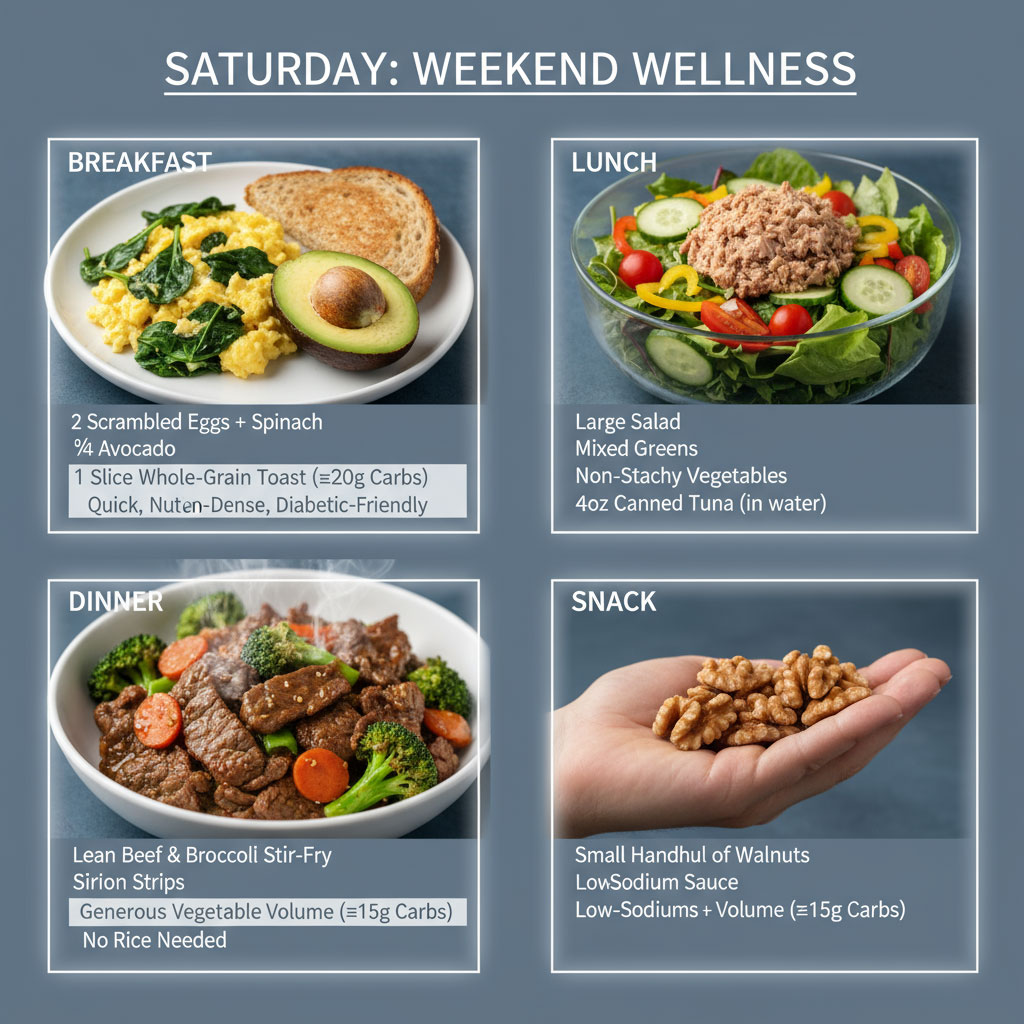
- Breakfast: 2 scrambled eggs with spinach and 1/4 avocado, served with one slice of whole-grain toast. This is one of the best diabetic breakfast ideas for Americans because it is quick, filling, and packed with nutrients. (Approx. 20g carbs)
- Lunch: Large salad topped with 4 oz of canned tuna (packed in water), mixed greens, and plenty of non-starchy vegetables.
- Dinner: Lean beef and broccoli stir-fry made with lean sirloin strips and a savory low-sodium sauce. The generous portion of vegetables provides enough volume that no rice is needed. (Approx. 15g carbs)
- Snack: A small handful of walnuts.
Sunday: Prep for Success

- Breakfast: 1 cup of plain Greek yogurt with 1/4 cup of sliced almonds. (Approx. 15g carbs)
- Lunch: Create a “bento box” style lunch using leftovers from the week, such as sliced chicken, raw veggies with hummus, and a handful of nuts.
- Dinner: 5 oz roasted chicken breast seasoned with herbs, served with 1 cup of roasted Brussels sprouts and 1/2 cup of roasted carrots. (Approx. 25g carbs)
- Pro Tip: Use Sunday evening to do some light meal prep for the week ahead, like chopping vegetables or cooking a batch of quinoa. This can make sticking to your plan much easier on busy weekdays.
- Snack: A small pear.
Foods to Embrace and Foods to Limit: A Clear Guide
Success beyond this initial 7-day diabetes meal plan hinges on understanding the fundamental building blocks of a healthy diet. A simple type 2 diabetes food chart can be an invaluable tool for making smart, confident choices at the grocery store and in your kitchen. This is not about memorizing lists of “good” and “bad” foods, but about learning which foods will fuel your body and help you thrive.
Here is a quick reference guide to the best foods for diabetes control and those you should aim to consume in moderation.
| Food Category | Foods to Embrace (Choose Often) | Foods to Limit or Avoid |
| Proteins | Skinless chicken/turkey, fish (salmon, tuna), eggs, beans, lentils, tofu | Fried meats, fatty cuts of red meat, processed meats (sausages, bacon) |
| Carbohydrates | Quinoa, brown rice, whole-wheat bread/pasta, oats, sweet potatoes, fruit | White bread/rice/pasta, sugary cereals, pastries, chips, crackers |
| Vegetables | Broccoli, spinach, bell peppers, salad greens, cauliflower (non-starchy) | Canned vegetables with added sodium, corn, peas, potatoes (in moderation) |
| Fats | Avocado, olive oil, nuts, seeds | Butter, margarine, palm oil, trans fats (in processed snacks) |
| Drinks | Water, unsweetened tea, black coffee | Soda, fruit juice, sweetened energy drinks, sweetened coffee |
A growing body of research highlights the particularly detrimental effects of ultra-processed foods. These items are not just problematic for their high sugar and unhealthy fat content; they can also negatively impact gut health and promote chronic inflammation, both of which are closely linked to worsening insulin resistance.
Beyond the Basics: Customizing Your Plan with Modern Tools
The future of the diabetic diet is profoundly personal. Modern technology now allows for a level of customization and real-time feedback that was unimaginable just a few years ago. These tools can transform a generic meal plan into a highly optimized one that is tailored specifically to your body’s unique responses.

The Rise of AI Meal Planning Apps
A new generation of AI-powered diabetes meal planner apps is fundamentally changing the game for millions. Tools like Foodvisor, MyNetDiary, and Season Health go far beyond simple calorie and carb tracking. They leverage the power of artificial intelligence to:
- Provide Truly Personalized Suggestions: Based on your eating habits, stated preferences, and specific health goals, these apps can suggest diabetes friendly recipes and meal combinations that you will actually enjoy eating.
- Simplify the Chore of Food Logging: Many of these advanced apps allow you to log an entire meal simply by taking a picture of it. Their image recognition technology identifies the different foods, estimates portions, and calculates the nutritional information for you.
- Analyze Your Nutrient Data Over Time: They provide a detailed, easy-to-understand breakdown of your intake of carbs, fats, protein, and fiber, helping you identify patterns and stay on track with your goals.
These tools are invaluable for anyone who wants to take a more data-driven and less stressful approach to their diabetes diet plan for the USA.
Personalized Diet Using Wearable Data: Connecting Your CGM
The true revolution in diabetes management comes when you create a personalized diet using wearable data diabetes tools, specifically a continuous glucose monitor (CGM). A CGM provides a constant stream of information, revealing precisely how your blood sugar responds to every single thing you eat, drink, and do.
By connecting your CGM data to a meal planning app, you create an incredibly powerful and immediate feedback loop. For instance, you might see that a bowl of white rice spikes your glucose to 190 mg/dL, but a similar portion of quinoa only raises it to a much healthier 140 mg/dL. This is concrete, actionable data you can use to make smarter choices at your very next meal, leading to far better and more stable glycemic control.
Comparing Popular Diabetes-Friendly Diet Patterns
While our 7-day diabetes meal plan offers a balanced and effective starting point, it is helpful to understand the major dietary patterns that have been extensively researched for diabetes management. The best long-term diet is always the one that is healthy, effective, and sustainable for your individual lifestyle. The Mediterranean diet for diabetes and a plant-based diabetes diet are two of the most highly recommended patterns by clinical experts.
Here is how they compare to a more restrictive low carb diabetes menu.
| Feature | Mediterranean Diet | Plant-Based Diet | Low-Carb Diet |
| Key Principles | Emphasizes fish, olive oil, fruits, vegetables, nuts, and whole grains. Focus on whole foods and healthy fats. | Excludes or minimizes animal products. Focus on vegetables, fruits, legumes, grains, nuts, and seeds. | Severely restricts all carbohydrate sources while significantly increasing fat and protein intake. |
| Proven Benefits | Improves A1c, dramatically reduces cardiovascular risk, supports healthy weight management, and is anti-inflammatory. | Can improve insulin sensitivity, lower cholesterol, aid in weight loss, and lower blood pressure. | Often leads to rapid initial weight loss and significant, fast reduction in A1c and triglyceride levels. |
| Potential Challenges | Can be higher in cost due to fresh fish and nuts; portion control of healthy fats like olive oil is still important. | Requires careful planning to avoid nutrient deficiencies (especially Vitamin B12, iron, and calcium). | Can be highly restrictive and difficult to sustain long-term; may increase LDL (“bad”) cholesterol in some individuals. |
| Best For… | Individuals seeking a balanced, heart-healthy, and sustainable long-term eating pattern that is enjoyable and flexible. | Those motivated by health, ethical, or environmental reasons who are willing to plan their meals carefully. | Individuals needing significant, rapid improvement in blood sugar and weight, ideally under close medical supervision. |
Landmark clinical studies, such as the renowned PREDIMED trial, have definitively confirmed the powerful cardiovascular benefits of the Mediterranean diet. Similarly, a wealth of research from entities like the Physicians Committee for Responsible Medicine has demonstrated significant improvements in A1c, cholesterol, and body weight for those who adopt a well-planned plant-based diet.
Summary & Key Takeaways for Lasting Success
Managing your diet for diabetes is not a pass-fail test; it is a journey of empowerment and self-discovery. It is about learning what works best for your body, your tastes, and your lifestyle. This guide is designed to equip you with the confidence and the foundational tools to take the first, most important steps on that journey toward better health.
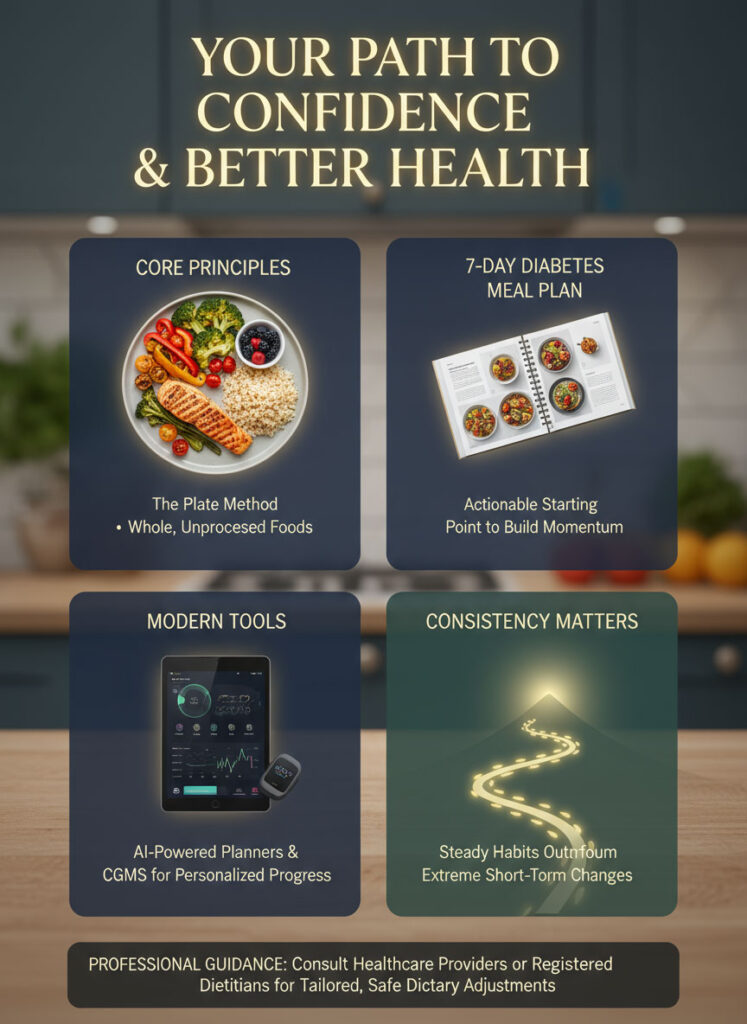
Here are the key takeaways to carry with you:
- Your foundation for success is the simple, visual Plate Method and a consistent focus on whole, unprocessed foods.
- This 7-day diabetes meal plan is a perfect, actionable starting point to build momentum and prove to yourself that you can do this.
- Embrace modern technology like AI-powered planners and CGMs to personalize your diet and accelerate your progress toward your health goals.
- Remember that consistency will always be more powerful than short-term, extreme changes. Start today and build healthy habits one satisfying meal at a time.
It is always crucial to consult with your healthcare provider or a registered dietitian before making significant changes to your diet. They can help you create a plan that is perfectly tailored, safe, and effective for your specific health needs and goals.
Frequently Asked Questions (FAQs)
What is the best simple 7-day menu for diabetes?
The best menu is one that is balanced, easy to prepare, and built on whole, unprocessed foods. It should feature a mix of lean proteins, abundant non-starchy vegetables, healthy fats, and high-fiber carbohydrates, much like the sample plan detailed in this article.
What foods should be strictly avoided in a diabetic meal plan?
You should strictly limit or avoid sugary beverages like soda, sweet tea, and fruit juice, as well as highly processed snacks, sweets, and foods made with refined white flour. These items offer little nutritional value and can cause rapid, unhealthy spikes in blood sugar.
How many carbs should a person with type 2 diabetes have per meal?
This is a highly individual number and depends on your age, activity level, medications, and overall health goals. While a common starting point recommended by the ADA is 45-60 grams of carbohydrates per meal, it is essential to work with your doctor or a registered dietitian to determine your specific, personalized target.
How do the new ADA/WHO guidelines change meal prepping for diabetics?
The latest guidelines strongly emphasize flexibility and personalization over old, rigid rules. This makes easy diabetes meal prep even more valuable, as it empowers you to control ingredients, manage portions, and ensure your meals are rich in the vegetables, lean proteins, and whole grains that your body needs.
Are plant-based diets like the one from the American Diabetes Association safer for diabetics?
A well-planned plant-based diabetes diet is considered very safe and highly beneficial for most people. A large body of research shows it can significantly improve insulin sensitivity, lower cholesterol, and aid in weight management. The ADA recognizes it as a healthy and effective eating pattern for managing diabetes.
How can I use my CGM data to adjust my meal plan?
By observing your CGM data after meals, you can identify which specific foods or even which portion sizes cause your blood sugar to spike beyond your target range. You can then use this direct feedback to adjust your plan, perhaps by swapping that food for a lower-carb alternative or reducing the portion size the next time you eat it.
What are the best snacks for U.S. diabetes patients to keep blood sugar stable?
The best snacks are those that combine protein, fiber, and healthy fats to prevent blood sugar swings. Excellent options include a small handful of almonds or walnuts, an apple with a tablespoon of peanut butter, plain Greek yogurt, a hard-boiled egg, or raw vegetables with hummus. These are all fantastic glucose control foods.
Is the Mediterranean diet better than a low-carb diet for diabetes?
Neither diet is definitively “better” for every single person. The Mediterranean diet for diabetes is frequently recommended for its proven long-term heart health benefits and its high degree of sustainability and enjoyment. A low-carb diet can be very effective for achieving rapid blood sugar reduction but may be more challenging to maintain. The best choice depends on your individual health profile, lifestyle, and preferences.
What are the best diabetic breakfast ideas for busy Americans?
Quick, simple, and healthy options are key for busy mornings. Consider oatmeal with berries, scrambled eggs with spinach, a smoothie made with protein powder and unsweetened almond milk, or a whole-wheat English muffin topped with mashed avocado. These choices provide sustained energy without causing a major blood sugar spike.
How do I start meal prepping for the week to follow this plan?
The key is to start small so you do not get overwhelmed. Pick just 2 or 3 dinner recipes for the upcoming week. Cook a large batch of a versatile whole grain like quinoa or brown rice. Wash and chop your vegetables ahead of time. You can also portion out snacks like nuts into small bags. This small investment of time makes assembling daily meals incredibly fast and easy.
Are specialty products like Glucerna necessary in a diabetic diet?
Products like Glucerna are not necessary for a healthy diabetes diet, but they can be a convenient option for a meal replacement or a planned snack when you are short on time. However, a diet based on whole, unprocessed foods should always be the priority for accessing the best foods for diabetes control.









